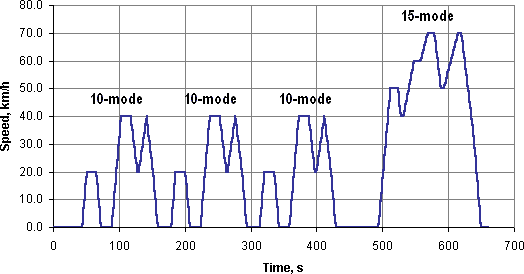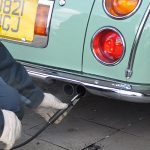Emissions
For those looking to register the car with local highways or government agencies we have the following data on Emissions.
| Carbon Dioxide (CO2)* |
179.7 g/km |
| Hydrocarbons (HC) | 0.16 |
| Carbon Monoxide (CO) | 1.20 |
| Nitrogen (NOx) | 0.22 |
*Source – https://car-emissions.com/cars/index/nissan+figaro

The graph shows the distance of the cycle is 4.16 km, average speed 22.7 km/h, duration 660 s (or 6.34 km, 25.6 km/h, 892 s, respectively, including the initial 15 mode segment).
Carbon Dioxide (CO2)
During combustion, the carbon (C) from the fuel combines with oxygen (O2) from the air to produce carbon dioxide CO2. The combustion process also produces heat that is converted into the mechanical energy that propels the makes the exhaust products heavier.Cars make a significant contribution to overall emissions of CO2 in the UK. Additionally, and especially in urban areas, road transport is also one of the major sources of emissions which are harmful to human health.
Hydrocarbons (HC)
A class of burned or partially burned fuel, hydrocarbons are toxins. Hydrocarbons are a major contributor to smog, which can be a major problem in urban areas. Prolonged exposure to hydrocarbons contributes to asthma, liver disease, lung disease, and cancer. Regulations governing hydrocarbons vary according to type of engine and jurisdiction; in some cases, “non-methane hydrocarbons” are regulated, while in other cases, “total hydrocarbons” are regulated. Technology for one application (to meet a non-methane hydrocarbon standard) may not be suitable for use in an application that has to meet a total hydrocarbon standard. Methane is not directly toxic, but is more difficult to break down in fuel vent lines and a charcoal canister is meant to collect and contain fuel vapors and route them either back to the fuel tank or, after the engine is started and warmed up, into the air intake to be burned in the engine.
Carbon Monoxide (CO)
A product of incomplete combustion, inhaled carbon monoxide reduces the blood’s ability to carry oxygen; overexposure (carbon monoxide poisoning) may be fatal. (Carbon monoxide persistently binds to hemoglobin, the oxygen-carrying chemical in red blood cells, where oxygen (O2) would temporarily bind. The bonding of CO excludes O2 and also reduces the ability of the hemoglobin to release already-bound oxygen, on both counts rendering the red blood cells ineffective. Recovery is by the slow release of bound CO and the body’s production of new hemoglobin—a healing process—so full recovery from moderate to severe [but nonfatal] CO poisoning takes hours or days. Removing a person from a CO-poisoned atmosphere to fresh air stops the injury but does not yield prompt recovery, unlike the case where a person is removed from an asphyxiating atmosphere [i.e. one deficient in oxygen]. Toxic effects delayed by days are also common.
Nitrogen NOx
Generated when nitrogen in the air reacts with oxygen at the high temperature and pressure inside the engine. NOx is a precursor to smog and acid rain. NOx is the sum of NO and NO2.[1] NO2 is extremely reactive. NOx production is increased when an engine runs at its most efficient (i.e. hottest) operating point, so there tends to be a natural trade off between efficiency and control of NOx emissions.
CATALYTIC CONVERTER
The Figaro is fitted with a catalytic converter, which is basically a filter whose job it to speed up the removal of pollution. As the gases from the engine fumes blow through the catalyst a chemical reactions take place on its surface, breaking apart the pollutant gases and converting them into other gases that are safe enough to blow harmlessly out into the air.
Due to the age of the car, in some countries this item can be removed which helps performance however before you consider removing this we suggest you check with your countries highways or government agencies.
ULTRA LOW EMISSIONS ZONE – LONDON (ENGLAND)
The Nissan Figaro does not currently meet the Emissions standard required to drive the car within the ULEZ (Ultra Low Emissions Zone) in London UK. To achieve this the car will require modification to the exhaust and catalytic converter and testing to ensure it meets the standard. Read more














